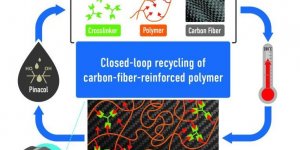Technology

In a win for chemistry, inventors at the Department of Energy’s Oak Ridge National Laboratory have designed a closed-loop path for synthesizing an exceptionally tough carbon-fiber-reinforced polymer, or CFRP, and later recovering all of its starting materials. »

Researchers have developed a sensor made from ‘frozen smoke’ that uses artificial intelligence techniques to detect formaldehyde in real time at concentrations as low as eight parts per billion, far beyond the sensitivity of most indoor air quality sensors. »

Oak Ridge National Laboratory researchers have developed a novel way to encapsulate salt hydrate phase-change materials within polymer fibers through a coaxial pulling process. »

Results could help pave the way for quantum infrastructure. »

Researchers have developed an augmented reality head-up display that could improve road safety by displaying potential hazards as high-resolution three-dimensional holograms directly in a driver’s field of vision in real time. »

The University of Tokyo scientists have achieved a breakthrough by integrating large language models (LLMs) with robots, marking a significant stride in enabling more humanlike gestures without relying on conventional hardware-driven controls. »

An international team of researchers has developed a handheld, non-invasive device that can detect biomarkers for Alzheimer's and Parkinson's disease. »

For the first time, researchers demonstrate how to electronically alter the direction of electron flow in promising materials for quantum computing. »

German company Cerabyte recently tested a prototype of its own data storage system using ceramic media, potentially heralding a shift away from traditional HDDs and SSDs in data centers by 2030. »

Dynamic crystallization control solves 2D halide perovskite synthesis bottleneck. »

Guided by machine learning, chemists at the Department of Energy’s Oak Ridge National Laboratory designed a record-setting carbonaceous supercapacitor material that stores four times more energy than the best commercial material. »

X-ray laser shows possible route to substantially increased precision time measurement. »

A floating, solar-powered device that can turn contaminated water or seawater into clean hydrogen fuel and purified water, anywhere in the world, has been developed by researchers. »

Graphene byproduct offsets 'flash' hydrogen production costs. »

Additive mixture stabilizes phase change material, unlocks potential for heat pumps. »

Neuron processes visual and tactile input together. »

Researchers develop novel bubble-based technique to watch immune cells at work. »

Sensitive technique could revolutionize treatment during pandemics. »

An international group of scientists based in Russia’s National Research University of Electronic Technology (MIET) have managed to promote glycine crystals' piezoelectric effect - where an electric charge is produced by applying pressure. »

Researchers tracked how current language models such as ChatGPT mistake nonsense sentences as meaningful. »

As current courses through a battery, its materials erode over time. Mechanical influences such as stress and strain affect this trajectory, although their impacts on battery efficacy and longevity are not fully understood. »

High energy density batteries could potentially outperform lithium-ion batteries. »

New technique produces perovskite nanocrystals right where they're needed. »

Engineers inspired by the morphing skins of animals like chameleons and octopuses. »

Device could lead to more effective brain cancer treatments. »

Microsoft announced the existence of a vulnerability referenced CVE-2023-36884 in several versions of Windows and Office products. »

Researchers have demonstrated how carbon dioxide can be captured from industrial processes – or even directly from the air – and transformed into clean, sustainable fuels using just the energy from the sun. »

The flammability of pine needles, a major fire hazard in the coniferous forests, makes them an abundant source of renewable energy, say researchers. »

Researchers have made a groundbreaking discovery in battery technology, finding a way to create an efficient battery using zinc, a readily available and inexpensive metal, instead of the rare metals typically used in lithium batteries. »

Bird with uncanny ability to hold water while it flies could inspire the next generation of absorbent materials. »

Understanding how this mechanism works could lead to quantum devices that do not need cooling to operate. »

Research aims to help semiconductor industry make computing less of an energy hog. »

Researchers at the U.S. Department of Agriculture's (USDA) Agricultural Research Service (ARS) bred four cotton lines that can be used to make self-extinguishing textiles when exposed to fire and will reduce the need for flame-retardant chemicals to be embedded in consumer products. »

Scientists have measured the highest toughness ever recorded, of any material, while investigating a metallic alloy made of chromium, cobalt and nickel, or CrCoNi. »
